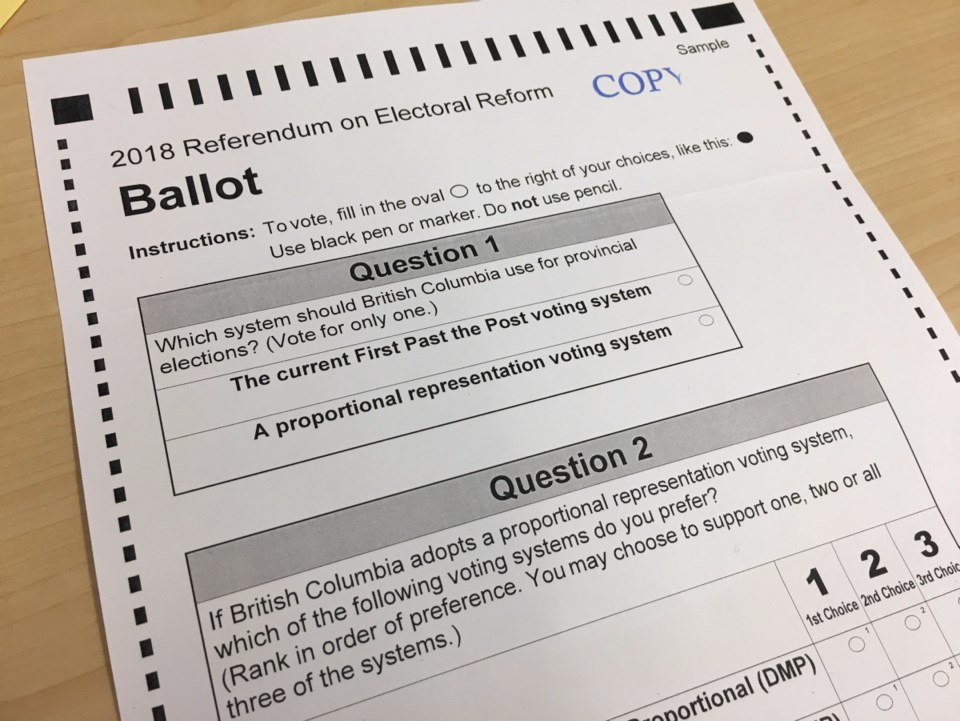So far, the Yes and No sides in the referendum debate have focused on the relative merits and demerits of proportional representation and first-past-the-post. In doing so they are neglecting a large elephant: the all-party legislative committee that is intended to fine-tune one of the three proposed PR systems into a workable scheme for implementation should the Yes side win.
As outlined in the attorney general’s report on PR, this committee would make decisions on matters such as the number of legislative seats and the proportion to be allocated to the “list” portion of the ballot. The issues in question might be taken as mere details. That might be a mistaken assumption, however.
The well-worn dictum “the devil is in the details” is surely nowhere more applicable than in the volatile area of electoral reform. One can make the argument that the decisions by the committee can have the effect of producing a system that falls short of what many people favouring PR might reasonably expect.
Of the 29 issues identified by the attorney general that have to be addressed by the committee, 10 relate to what many see as the leading option, mixed-member proportional. They include not only the ratio of constituency to proportional seats and the boundaries of the electoral regions, but also the form and openness of the party list from which the proportional seats are drawn.
The really crucial decisions are: On the ballot, will there be single choice covering both local candidates and the proportional list or will voters be able to choose a local candidate from one party and choose a list for a different party? Will the list be open or closed; that is, will voters be able to rank those on the list or will it be closed? There are also related questions. Who will select the candidates for the party list? Will it be the party executive or the membership at large? Will this selection process be regulated by government or left to the parties themselves?
The answers are enormously important. MMP supporters typically point to New Zealand — which uses a variant of MMP with separate choices for candidate and party and an open list — strongly intimating that this is what we’ll get if we say Yes and mark the MMP option. New Zealand certainly sets the gold standard.
But if the elephant, that is the committee, decides on a single-choice, closed-list ballot, we’ll end up with something far short of the New Zealand standard. For some, this would be worse than our current FPTP system.
How will the committee do its work? We don’t really know. According to the attorney general’s report, the committee “should” receive input from the public, as well as from experts and election administrators, but there appears to be no guarantee it will. Will it hold public hearings? Will there be a web-based consultation process? Again, we don’t know. What we do know is that the committee will have only three months to do its work, suggesting there won’t be a lot of time for public consultation.
It will be an all-party committee, its composition reflecting the legislature, which means the NDP and the Greens combined will have a majority. All parties have strategic interests, with the Greens clearly having the most at stake, seeing PR as the path to move from three seats to many times that number. The NDP is lukewarm, as reflected in negative comments by former party leaders and trade-union allies. Much of the backroom negotiations will likely come down to what Premier John Horgan and B.C. Green Party Leader Andrew Weaver consider to be an acceptable trade-off. What would that look like?
An optimistic scenario would have both party leaders opt for an open system, recognizing that the legitimacy of the system depends on maximizing citizen choice. A pessimistic scenario would see Horgan favouring a more closed system to assuage those in the NDP unhappy with the loss of FPTP. Weaver, in turn, desperate for PR, any PR, could accede to a closed system, even if that weren’t his first choice. Such a scenario could be justified by the committee as favouring simplicity: “Voters don’t like complicated ballots.”
Given the possibility of the pessimistic scenario prevailing, should cautious PR supporters vote No? Not necessarily. The lesson here is that during the referendum period, citizens of all partisan stripes have to ask the three party leaders where they stand on ballot configuration and to reject any answer of: “We’ll leave it to the committee to decide.” And after a successful Yes vote, citizens have to hold the collective feet of the legislative committee, and those of the party leaders, to the fire so that citizen interests, not party interests, will prevail.
To do anything less and end up with a PR system that is closed, disrespecting the principle of voter choice, would be deeply unfortunate.
Herman Bakvis is emeritus professor of public administration at the University of Victoria.



